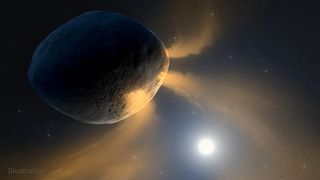News
Science & Astronomy

This illustration depicts asteroid Phaethon being heated by the Sun. The asteroid’s surface gets so hot that sodium inside Phaethon’s rock likely vaporizes and vents into space, causing it to brighten like a comet and form a tail.
(Image credit: NASA/JPL-Caltech/IPAC)
For quite a while, an asteroid named Phaethon has presented astronomers with something of a conundrum.
When it passes closest to the sun during its orbit, a long tail of material can be seen leaving the three-mile-wide (five-kilometer-wide) rock. However, if Phaethon’s tail is the stuff of usual comets — ice and carbon dioxide — then it should be visible when the comet is as far away as Jupiter, too. But it’s not.
Scientists have therefore had some theories about what Phaethon might be composed of, which could explain what trails behind when the asteroid passes by the Sun. And in new research, astronomers have compared the infrared emissions of Phaethon analyzed by NASA’s Spitzer space telescope to emissions of meteorites in laboratories, ultimately finding that Phaethon likely belongs to a rare class of meteorite, of which only six specimens are known.
Related: The strange mystery of asteroid Phaethon’s comet-like tail
Namely, Phaethon’s emission spectrum corresponds to a type of meteorite called the “CY carbonaceous chondrite.” Conversely, other well known asteroids such as Ryugu and Bennu, targets of the recent JAXA and NASA sample-return missions, are CI and CM meteorites respectively.
All three classes of meteorites are believed to have originated during the birth of the solar system, as they all show signs of the chemical process in which water combines with other molecules to form phyllosilicate and carbonate materials. However, only the CY group seemed to show signs of drying and decomposition due to heating; it also exhibits a high iron sulfide content, which suggests a unique origin.
Analyses of Phaethon’s emission spectrum revealed olivine, carbonates, iron sulfides and oxide minerals — all of which supported the space rock’s connection to the CY class of asteroid. Carbonates in the asteroid indicate changes in water content (the drying), for instance, and the olivine is consistent with thermal decomposition of phyllosilicates at high temperatures.
Researchers were able to show with thermal modeling how temperatures, such as those encountered when passing by the sun, might affect minerals in the asteroid that release gases. As the asteroid gets nearer the searing ball of plasma at our solar system’s center, its surface temperatures can rise to 800°C, which the team says is easily hot enough for the object’s carbonates to produce carbon dioxide, phyllosilicates to release water vapor and sulfides sulfur gas.
Data from other studies on asteroids, combined with the new thermal models of Phaethon, led the researchers to believe that pressure from the gas released by the asteroid heating up could cause the rock to break down, producing small dust particles that are lifted from its surface — a likely explanation for Phaethon’s tail as it passes by the sun.
“It was great to see how each one of the discovered minerals seemed to fall into place and also explain the behavior of the asteroid,” said co-author Mikael Granvik from the University of Helsinki, in a press release.
The research was published in November in the journal Nature Astronomy.
Join our Space Forums to keep talking space on the latest missions, night sky and more! And if you have a news tip, correction or comment, let us know at: [email protected].
Breaking space news, the latest updates on rocket launches, skywatching events and more!
Conor Feehly is a New Zealand-based science writer. He has earned a master’s in science communication from the University of Otago, Dunedin. His writing has appeared in Cosmos Magazine, Discover Magazine and ScienceAlert. His writing largely covers topics relating to neuroscience and psychology, although he also enjoys writing about a number of scientific subjects ranging from astrophysics to archaeology.
>>> Read full article>>>
Copyright for syndicated content belongs to the linked Source : Space.com – https://www.space.com/asteroid-phaethon-rare-class-solar-system






























